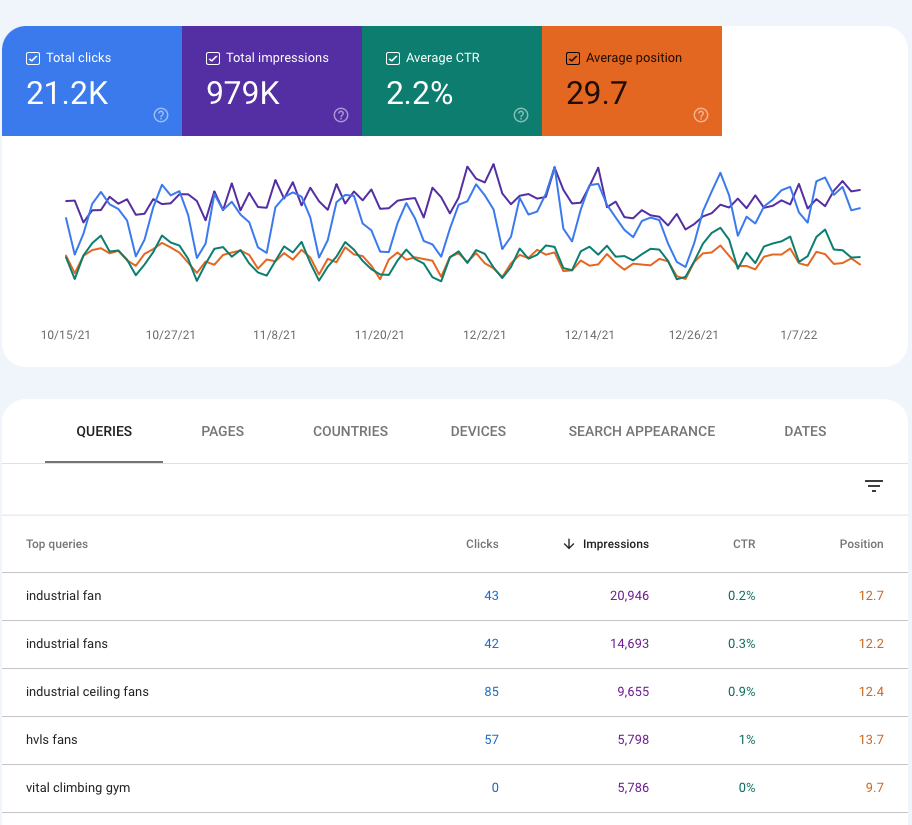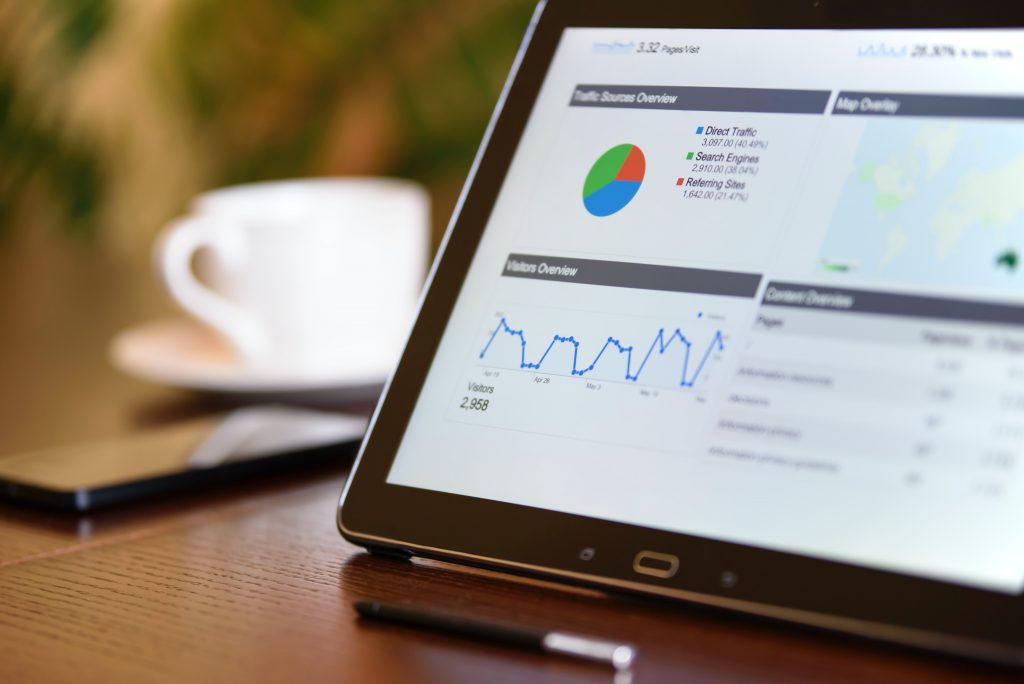You may have a basic understanding of SEO metrics, or maybe you have a full-fledged SEO strategy running. Either way, without tracking your SEO KPIs (key performance indicators) do you really have a way of knowing whether the money and effort going into your website’s SEO is truly worthwhile and lining up with your business goals? The answer is definitely not.
When it comes to SEO, it can be difficult to pinpoint which SEO KPIs you should be tracking. We all want to rank at the top of the major search engines for all search terms, but that is not a strategy on its own!
Luckily, we’re here to help. We’ll highlight 11 important KPIs that you absolutely need to be measuring. By the end, you’ll have a much better idea of which SEO KPIs your SEO performance report should include. We’ll also briefly be covering how you can use free tools available such as Google Analytics and Google Search Console to better understand the behavior of those visiting your website and how they are ultimately coming across your site.
Google Analytics and Google Search Console
Both Google Analytics and Google Search Console are must-have SEO tools. They will help you understand the user’s journey to your website and what they do once they are there. You may wonder why you need both at first, but we’ll explain.
Google Search Console is a program that will give insight into how your website is being seen on Google. Additionally, Google Search Console can help you understand which pages are your most popular, as well as which web pages you may need to improve to increase your visibility and enhance user experience.

While Google Analytics is geared toward tracking visitors from many origins, not just the Google search engine. Google Analytics will give you a more robust understanding of your user demographics, behavior, bounce rate, among many other things.

Now that we’ve covered the two Google programs that you can use to track KPIs and your website performance, we’re going to dive into which SEO KPIs we strongly suggest you be paying attention to. While this list is not exhaustive, these are the KPIs that we think are among the most important and can provide you the most insight as to whether or not your SEO strategy is successful.
SEO Conversion Goals
While this may seem like an incredibly obvious one, conversion metrics are the most essential KPI to measure the overall success of your SEO strategy. Conversions are simply the actions that you want the visitor to take when visiting your website. For instance, when your goal is for users to make an online purchase, a conversion is the action of that visitor completing the purchase. However, we challenge you to consider the entire conversion funnel and measure each step. It can be as simple as wanting a visitor to visit a specific page or sign up for your email newsletter.
Organic conversions and organic conversion rate are one of the most valuable KPIs to evaluate your SEO strategy because they can be seen directly in your bottom line. By establishing conversion goals you can safely assume that your strategy is working well because it is convincing your website users to become your customers.
Organic Visibility
Organic Visibility refers to the number of free (non-paid) impressions that your website receives from search engines such as Google. Impressions are a great way to indicate how your website is ranking on search results. You’ll typically notice that impressions will increase before clicks. The best way to increase organic visibility is to optimize your website through relevant and regular content updates and strategic meta titles and descriptions. You will also want to focus on ensuring that your website is optimized to be mobile-friendly. All of these steps should in an ideal world help to greatly boost your organic visibility.
Organic Traffic
Organic traffic/SEO traffic refers to the number of visitors coming to your website from organic search results. There are two types of organic sessions that are important to track, branded searches and non-branded searches. You will want to pay closer attention to the non-branded traffic as it is a better indicator of your SEO performance.
- Branded organic traffic is typically a result of the user having previously known about your brand or product. This previous knowledge can be from word of mouth, being exposed to an ad campaign or PR campaign, or even from coming across your product or service through social media. The user then searches for your product or service directly in their search engine and boom, they find your website.
- Non-branded organic traffic, on the other hand, is when a user enters a question or phrase and contains keywords in their search engine that are related to your product or service. If your listing shows up, that means that it is ranking highly on SERPs (Search Engine Results Pages). Non-branded organic traffic is a better indicator of the effectiveness of your SEO because it will indicate whether you rank higher on search engine results due to keywords or other factors.
Keyword Rankings/Search Engine Position
Keyword ranking positions can make a considerable difference in your SEO success as a majority of people tend to click on a search result that appears on the first page of their SERP. This is why it’s important to brainstorm relevant keywords for your target audience that have high search volume and low competition.
If your target keywords rank highly, you have a greater chance of showing up on the first search results page, which leads to more exposure and organic search traffic to your website. It’s important to diversify your keywords and make sure that they are highly relevant to your website content strategy. You can use different tools to figure out which keywords are benefitting you most and which you could probably do without. Tools such as Google Search Console, SEMrush, and more will give you insight into your organic keyword position, how you stack up against others using the same keywords, and more.
Organic CTR
In general terms, organic CTR (Click-through-rate) is the percentage of people that are clicking on your website listing when it shows up on their SERP. Essentially, a high organic CTR demonstrates that your SEO strategy is doing its job successfully, the higher the CTR the more traffic your site is getting. A higher organic CTR can also indicate that your meta description and title are relevant and attention-grabbing, leading people to click on the link to your website.
Bounce Rate
Bounce rate is the rate at which users decide to leave after landing on your website without visiting any other pages. This is a great metric to track because it gives insight into whether users find your web content to be engaging. A higher bounce rate usually conveys that your page isn’t captivating the audience’s attention. This could be that your copy isn’t interesting enough or that the user isn’t finding the information that they were looking for, and they end up exiting the site. It’s worth mentioning that the bounce rate is typically 50% and can vary wildly between industries, so don’t get discouraged if the number seems higher than it should be.
Great ways to help lower your bounce rate include ensuring your page speed is up to par so that there are no loading issues, having an eye-catching call or click to action, having a clear and captivating copy, including engaging and thoughtful graphics or photos, and steering clear of using heavy ad banners or pop-ups on your landing page.
Top Exit Pages
Top exit pages are pretty self-explanatory, they are the pages where users are most likely to exit your website. Paired with the average time on page and number of pages visited, knowing your top exit pages will provide a better overview of the entire user journey throughout your website. It’s important to spend time thinking about user experience and conversion optimization. Is the content thin, are there no internal links, is the load speed slow?
When a page has a high exit rate, that doesn’t necessarily mean that the content isn’t engaging or that you need to drastically change anything about it. It’s possible that a page is just a good end to the user journey, such as an FAQ page, contact page, or a ‘thank you’ page. But it is important to ensure that you are making conversions throughout that journey whenever possible before the average user decides to leave your site.
Average Time on Page
The average session duration indicates how long the average user spends navigating through a specific web page of your website. The more captivating and interesting your content is, the more time a user will spend visiting the different pages throughout the website and the more likely they are to engage with the content.
This KPI is specifically important because, for instance, if you have a product or service you are looking to sell, a higher average session duration statistically will result in that customer making a purchase of that product or service. If the average time spent on your web page is low that means the user experience isn’t robust and needs improvement to convince your audience to spend more time browsing through your site. Average time on a particular page can give you an even more specific idea of which pages are most engaging and which content users are looking for.
Number of Pages Visited
The number of pages visited is exactly as it sounds, the more pages a user visits on your website means that they are spending time browsing through your content. Paired with the average time on page this can give you great insight into how each page is performing and how it contributes to the entire user experience that makes up your website. For instance, if a user enters the site onto a landing page and then browses three more pages before leaving, that means that some content caught their attention and enticed them to stay and browse around some more. The more pages they visit the more they are exploring the website and engaging with the content, and if you can make conversions along the way then your SEO and your website worked together to get the job done!
Technical Issues and Page Speed
This may seem like an obvious one. Page speed and the ease of user experience is critical piece to your SEO. There is a direct correlation between slow page load time as well as technical difficulties navigating the website and the bounce rate of users.
Simply put, if you’re browsing a website with poor page speed and every page takes a significant amount of time to load and also has a variety of technical issues, like broken links and poor internal linking, why would you want to spend much time there? The truth is you wouldn’t. Not to mention these issues make it much more difficult for your customers to make a purchase, and it’s safe to say that when making a purchase becomes stressful and cumbersome, most customers would rather do without the product or find an alternative. 2 great free resources for measuring your page speed that we use are GTmetrix and Google Page Speed.
SEO ROI (Return on Investment)
SEO ROI is the return on investment of your SEO strategy. In simple terms this means the difference in money invested into your SEO efforts and the return that you make from these efforts. We evaluate SEO the same as other marketing channels. It needs to provide more value than we spend.
The mission of creating an SEO strategy is different for everyone, but generally, the goal is to make conversions. Your content marketing strategy needs to be in line with all your other SEO success metrics. Remember search visibility search ranking means nothing if they are for the wrong audience. If you aren’t seeing an increase in conversions as a result of your SEO, then that gives you an idea of how well your current strategy is doing and that maybe it’s time to switch things up and reassess the customer journey. SEO ROI is probably the broadest of the SEO KPIs because it displays whether your overall efforts have been worth the time and money invested.
We hope you found our 11 KPIs for SEO useful! Knowing what KPIs and SEO metrics to measure, and understanding what they can each tell you about different aspects of your SEO strategy can give you the confidence to assess your SEO effectively. Having the ability to decipher the facets of your SEO that are performing well, and which are underperforming, will give you a better idea of how to adjust and adapt your SEO to be more productive. We hope that we’ve helped give more insight into which KPIs will help you measure your SEO success, and if you still have questions or need help dialing in your SEO strategy Synthesis Insights is here for all digital marketing needs.




